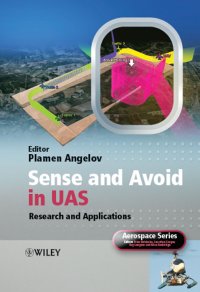
Ebook: Sense and avoid in UAS: research and applications
Author: Plamen Angelov (editor)
- Genre: Technique // Aerospace Equipment
- Series: Aerospace series
- Year: 2012
- Publisher: Wiley
- Edition: 2
- Language: English
- pdf
There is increasing interest in the potential of UAV (Unmanned Aerial Vehicle) and MAV (Micro Air Vehicle) technology and their wide ranging applications including defence missions, reconnaissance and surveillance, border patrol, disaster zone assessment and atmospheric research. High investment levels from the military sector globally is driving research and development and increasing the viability of autonomous platforms as replacements for the remotely piloted vehicles more commonly in use.
UAV/UAS pose a number of new challenges, with the autonomy and in particular collision avoidance, detect and avoid, or sense and avoid, as the most challenging one, involving both regulatory and technical issues.
Sense and Avoid in UAS: Research and Applications covers the problem of detect, sense and avoid in UAS (Unmanned Aircraft Systems) in depth and combines the theoretical and application results by leading academics and researchers from industry and academia.
Key features:
- Presents a holistic view of the sense and avoid problem in the wider application of autonomous systems
- Includes information on human factors, regulatory issues and navigation, control, aerodynamics and physics aspects of the sense and avoid problem in UAS
- Provides professional, scientific and reliable content that is easy to understand, and
- Includes contributions from leading engineers and researchers in the field
Chapter 1 Introduction (pages 1–34): George Limnaios, Nikos Tsourveloudis and Kimon P. Valavanis
Chapter 2 Performance Tradeoffs and the Development of Standards (pages 35–54): Andrew Zeitlin
Chapter 3 Integration of SAA Capabilities into a UAS Distributed Architecture for Civil Applications (pages 55–84): Pablo Royo, Eduard Santamaria, Juan Manuel Lema, Enric Pastor and Cristina Barrado
Chapter 4 Regulations and Requirements (pages 85–117): Xavier Prats, Jorge Ramirez, Luis Delgado and Pablo Royo
Chapter 5 Human Factors in UAV (pages 119–142): Marie Cahillane, Chris Baber and Caroline Morin
Chapter 6 Sense and Avoid Concepts: Vehicle?Based SAA Systems (Vehicle?to?Vehicle) (pages 143–173): Stepan Kopriva, David Sislak and Michal Pechoucek
Chapter 7 UAS Conflict Detection and Resolution Using Differential Geometry Concepts (pages 175–204): Hyo?Sang Shin, Antonios Tsourdos and Brian White
Chapter 8 Aircraft Separation Management Using Common Information Network SAA (pages 205–232): Richard Baumeister and Graham Spence
Chapter 9 AgentFly: Scalable, High?Fidelity Framework for Simulation, Planning and Collision Avoidance of Multiple UAVs (pages 233–264): David Sislak, Premysl Volf, Stepan Kopriva and Michal Pechoucek
Chapter 10 See and Avoid Using Onboard Computer Vision (pages 265–294): John Lai, Jason J. Ford, Luis Mejias, Peter O'Shea and Rod Walker
Chapter 11 The Use of Low?Cost Mobile Radar Systems for Small UAS Sense and Avoid (pages 295–336): Michael Wilson